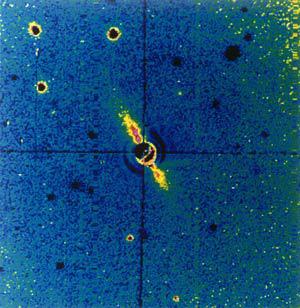This is truly astonishing: an “amateur” astronomer in New Zealand, Rolf Olsen, has for the first time actually been able to get a direct photograph of the disk of swirling material forming a planet around a nearby star!
Holy wow!
OK, first, the picture:

Photo by Rolf Olsen, used by permission
This may not look like much at first glance, but that’s often true of amazing pictures. When you realize what you’re actually seeing…
This is a picture of Beta Pictoris (or just β Pic to those in the know), a young star just over 60 light years away. The light from the star itself has been subtracted away (more on that in a sec), and the two big crosshair streaks of light are called diffraction spikes – they’re caused by light inside the telescope and aren’t real. But the fuzz you see above and below the star is real, part of the disk of material forming planets right before our eyes! The dashed line was added by Rolf to show the orientation of the disk.

Photo by Las Campanas observatory
In the 1980s, infrared images of β Pic revealed that it’s surrounded by a flat dust disk almost exactly edge-on to us. We see that disk as a broad line crossing the star itself, like in the false-color image here from the Las Campanas observatory.
β Pic became a very popular object, with many telescopes pointed at it to try to determine the nature of this material. This was the first time we had ever directly seen the disk of protoplanetary material. We now know that not only is that disk actively forming planets, there is a planet orbiting the star inside that disk, and we’ve even seen it move!
I’ve posted a gallery of exoplanet images, several of which show the best pictures of β Pic and its planet ever taken. The disk wasn’t discovered until the 1980s because the star is so bright its light swamps the much fainter material around it. The disk is huge, bigger than our solar system, but so far away – 600 trillion kilometers! – that it appears small in telescopes, and very close to the star. What Rolf did was to get rid of all that unwanted light. He first took a bunch of pictures of β Pic, and then took a second bunch of pictures of another star, Alpha Pictoris, which is very similar in brightness and color. He subtracted the image of the second star, removing the glare from β Pic itself. Adjusting for brightness is easy – that’s just a bit of algebra – but color was critical. Cameras respond differently to different colors, so making sure the two stars had the same hue was very important.
And it worked! He says the raw subtracted image was messy, so he cleaned it up a bit to make the disk easier to see. I’ll note that the method he used is very close to what I myself did years ago when I was working on a project to use Hubble to observe planet-forming disks! It’s also used to see exoplanets themselves as they orbit their stars. The method is tried and true, and worked well for Rolf.
The disk of material stretches just long enough to be seen in the image. But is it real?
I decided to check. In the Las Campanas observatory picture above, you can three stars near β Pic (the black dots with bright halos; remember, it’s false color), and I saw three stars in Rolf’s image that looked to be the same ones. I rotated the Las Campanas image and resized it; it’s inset in the image here. Note the three stars; I marked those same stars in Rolf’s image with arrows (one is right on β Pic’s diffraction spike, but you can still see it). As you can see, it’s a good match, and it also gets the size and the orientation of the disk right as well.
Looks like he nailed it!
Which is amazing. I wouldn’t have thought it was possible, especially with only a 25 cm (10 inch) telescope! β Pic is a bright star, so it’s easy to spot from the southern hemisphere, but the disk is so faint and so overwhelmed by the star light I would’ve thought it couldn’t be seen. But there you go: a bold experiment has paid off.
I wonder how many others of these are out there, too. Telescopes and cameras are getting better all the time. I still think getting a direct picture of a planet orbiting another star is beyond the current capability of small ‘scopes… but it is not only possible but relatively easy to detect them if they pass directly in front of (” transit”) their host star, blocking its light a little bit. So not only can we detect their presence using backyard telescopes, as Rolf has shown it’s possible to see the material from which they formed!
My sincere and hearty congratulations to Rolf Olsen for achieving this (and you should look through his gallery of astrophotographs; they’re beautiful and some are astonishing). I think it’s a milestone in “amateur” astronomy, and it goes to show you that sometimes, the sky is not the limit.
Tip o’ the dew shield to antcaesar on Twitter. I’ll note that while writing this I found Universe Today has written about it as well.